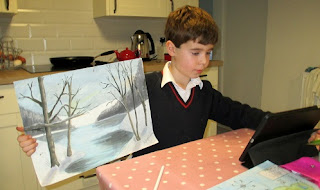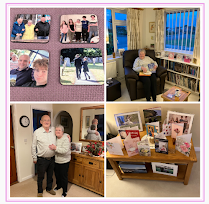17 Feb 2019
Sunspots - Sunday February 17th 2019
Solar flux is 70 and the sunspot number zero. A=4 and K=1.
Labels:
sunspots
16 Feb 2019
QSY to 472kHz WSPR
At about 1837z, I QSYed to 472kHz WSPR with 10mW ERP from the earth-electrode "antenna" in the ground.
QSYed from 10m FT8
At the moment, I am looking on 1.84MHz FT8 RX, although I think I'll try 472kHz WSPR (10mW ERP) shortly. Even within a few minutes, much of Europe was coming through again on 160m FT8 RX.
 |
Stations received within a few minutes on 160m FT8
RX with the earth-electrode "antenna" in the ground.
|
Earth-electrode "antenna" further description
 |
| Earth-electrode "antenna" system - click to enlarge |
 |
| 3C90 step-up transformer |
At this QTH I use a 3C90 42mm diameter toroid with 2t on the primary (connected to the rig or transverter) and a 20t secondary (connected to the "antenna"). This was empirically wound to give best match and best ERP. I hope the diagram and photo helps. The video was at the old QTH.
Labels:
earth-electrode
Oscar 100
Only time will tell how this geosynchronous satellite (Es'hail2) will work out. At the moment, it seems to be working well with about 6-8 users at one time. As time goes by, I expect more people will get active on it. In the end it could get quite busy.
Will the initial enthusiasm wane? Will people soon tire of this "repeater in the sky"? OK it is 22000 miles up, but once you have worked a few stations, you know you can work just about anybody that is in range across the planet with suitable gear. At the moment it is novel to be able to work real DX with ease on microwave frequencies at any time.
At the moment I am monitoring on the web SDR. See https://eshail.batc.org.uk/nb/
Will the initial enthusiasm wane? Will people soon tire of this "repeater in the sky"? OK it is 22000 miles up, but once you have worked a few stations, you know you can work just about anybody that is in range across the planet with suitable gear. At the moment it is novel to be able to work real DX with ease on microwave frequencies at any time.
At the moment I am monitoring on the web SDR. See https://eshail.batc.org.uk/nb/
Labels:
oscar100
10m FT8 during the day
As per usual, I am on 10m FT8 RX during the day. Just one G spotted so far G4HZW (212km). No sign here of much activity today.
UPDATE 1425z: HB9DFP (714km) best DX spotted today on 10m FT8 RX. Just 3 spots in all here.
UPDATE 1425z: HB9DFP (714km) best DX spotted today on 10m FT8 RX. Just 3 spots in all here.
Witch hazel? - NOT amateur radio
I am definitely not a plant expert! This was seen at Anglesey Abbey a few days ago. I think it is witch hazel, although I am not sure. If it is, I am not sure why it got this name.
Labels:
witch hazel
160m FT8 RX overnight
A pretty good period with 403 different stations spotted on 160m FT8 RX in the last 24 hours with 16 North Americans spotted overnight. Best DX was N5TZH (7537km) in Louisiana. Yet again, using the earth-electrode "antenna" in the ground.
Sunspots - Saturday February 16th 2019
Solar flux is 70 today and the SSN zero. A=4 and K=1.
Labels:
sunspots
15 Feb 2019
Budding artist - NOT amateur radio
Our 9 year old grandson is a great artist. This is his latest. Like many youngsters, he seems addicted to the iPad. There are other examples of his artwork on my main website. He is a good all-rounder and enjoys several sports. Of all our grandchildren, he is probably the most sociable and rounded.
Labels:
grandson
Subscribe to:
Posts (Atom)





